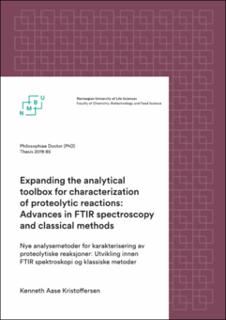| dc.contributor.advisor | Horn, Svein Jarle | |
| dc.contributor.advisor | Afseth, Nils Kristian | |
| dc.contributor.advisor | Lindberg, Diana | |
| dc.contributor.author | Kristoffersen, Kenneth Aase | |
| dc.date.accessioned | 2021-10-07T10:32:25Z | |
| dc.date.available | 2021-10-07T10:32:25Z | |
| dc.date.issued | 2019 | |
| dc.identifier.isbn | 978-82-575-1647-5 | |
| dc.identifier.issn | 1894-6402 | |
| dc.identifier.uri | https://hdl.handle.net/11250/2788357 | |
| dc.description.abstract | Enzymatic protein hydrolysis is a well-established industrial process recognized for its potential to improve sustainability in food production by valorization of protein-rich byproducts from the food industry. Monitoring such processes is still a significant challenge, as the existing classical analytical methods are not easily applicable to industrial environments. The lack of fast analytical tools to monitor and control enzymatic protein hydrolysis processes results in high variation in product quality, reducing the possible applications of the hydrolysate products in food and other supplements. The aim of this thesis was, therefore, to expand the analytical toolbox for characterization of proteolytic reactions by the development of new applications based on FTIR spectroscopy and classical analytical methods.
This thesis presents methods and approaches that can be adapted to industrial setups as process control and monitoring tools. The four papers that are part of this work also address, in one way or the other, the need for new analytical approaches in this industry. The focus of the three first papers was FTIR-based methods to monitor protein degradation during proteolytic reactions. Dry-film FTIR spectra were used to monitor this development in complex reaction mixtures. Partial least squares regression calibration models were then constructed to predict the two common protein hydrolysate quality parameters, degree of hydrolysis and average molecular weight, by linking the FTIR spectra to classical analysis results. The fourth paper showed how different poultry raw materials and enzyme products affected the protein degradation pattern and the product quality of protein hydrolysates.
The work conducted has resulted in a substantial analytical data library, including analytical data of raw materials, hydrolysate products and degradation patterns by following degree of hydrolysis and average molecular weight during enzymatic protein hydrolysis processes. The data collected will be useful in future EPH studies. Overall, the present work represents a step forward towards the increased use and valorization of existing protein resources, as it offers new methods and approaches to monitor, control and understand ongoing enzymatic protein hydrolysis processes. | en_US |
| dc.description.abstract | Enzymatisk proteinhydrolyse er en veletablert industriell prosess som gir muligheter for økt utnyttelse av proteinrike biprodukter fra matindustrien, og dermed en mer bærekraftig matproduksjon. Overvåking av slike prosesser er fremdeles en betydelig utfordring siden de eksisterende klassiske analysemetodene ikke enkelt kan brukes industrielt. Mangelen på raske analyseverktøy for å overvåke og kontrollere enzymatiske proteinhydrolyseprosesser resulterer ofte i høy variasjon i produktkvalitet. Dette er med på å begrense de mulige bruksområdene for hydrolyseproduktene. Målet med denne avhandlingen var derfor å utvikle nye karakteriseringsteknikker, basert på FTIR-spektroskopi og klassiske analysemetoder, for å kunne følge proteolytiske reaksjoner.
Denne avhandlingen omhandler nye metoder som kan benyttes til prosesstyring og prosessovervåking. De fire artiklene som er en del av dette arbeidet tar på ulike måter for seg behovet for nye analytiske løsninger innen enzymatisk proteinhydrolyse. De tre første artiklene viser hvordan FTIR-spektroskopi kan benyttes for å overvåke proteolytiske nedbrytningsreaksjoner. Tørrfilm FTIR-spektroskopi ble benyttet for å følge nedbrytningen av proteiner i komplekse reaksjonsblandinger, og kvantitative modeller basert på FTIR-spektre og resultater fra klassiske analyser av proteinhydrolyseprøver ble utviklet. Resultatene viser at metodene kan benyttes til å raskt estimere både hydrolysegrad og gjennomsnittligmolekylvekt, som er to vanlige kvalitetsparameterne benyttet i hydrolyseindustrien. Den fjerde artikkelen viser hvordan forskjeller i biproduktsammensetning fra kylling og kalkun, samt ulike enzymtyper, påvirker proteinnedbrytningsprosessen. Resultatet fra analysene viser blant annet at det er forskjeller i nedbrytningsmønsteret og produktkvaliteten til proteinhydrolysatene som ble produsert.
Arbeidet har resultert i et omfattende databibliotek med resultater fra analyser av biprodukter før prosessering, hydrolyseprodukter og prøver tatt ut under hydrolyseprosessen. I kombinasjon med nye og eksisterende måledata, vil dette databiblioteket være svært nyttig også i fremtidige studier. De nye metodene som er utviklet for å kunne overvåke enzymatiske proteinhydrolyseprosesser representerer et viktig skritt mot økt bruk av eksisterende proteinressurser og dermed økt bærekraft i dagens matproduksjon. | en_US |
| dc.language.iso | eng | en_US |
| dc.publisher | Norwegian University of Life Sciences, Ås | en_US |
| dc.relation.ispartofseries | PhD Thesis;2019:85 | |
| dc.rights | Attribution-NonCommercial-NoDerivatives 4.0 Internasjonal | * |
| dc.rights.uri | http://creativecommons.org/licenses/by-nc-nd/4.0/deed.no | * |
| dc.subject | Fourier-transform infrared spectroscopy | en_US |
| dc.subject | Enzymatic protein hydrolysis | en_US |
| dc.subject | Degree of hydrolysis | en_US |
| dc.subject | Average molecular weight | en_US |
| dc.subject | Partial least squares regression | en_US |
| dc.title | Expanding the analytical toolbox for characterization of proteolytic reactions : advances in FTIR spectroscopy and classical methods | en_US |
| dc.title.alternative | Nye analysemetoder for karakterisering av proteolytiske reaksjoner : utvikling innen FTIR spektroskopi og klassiske metoder | en_US |
| dc.type | Doctoral thesis | en_US |
| dc.relation.project | Nofima: Peptek | en_US |

